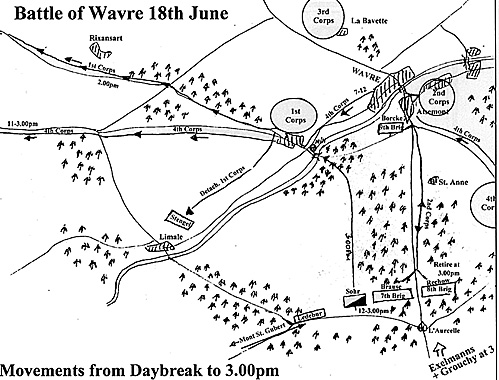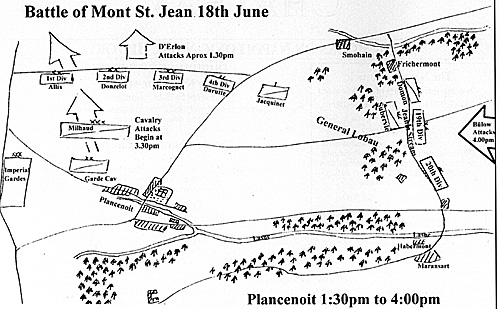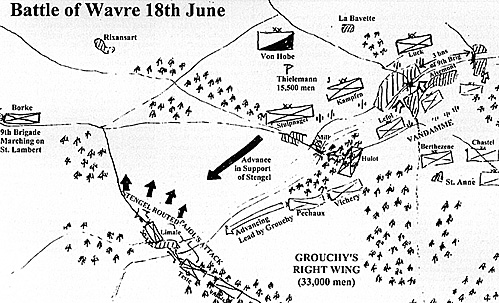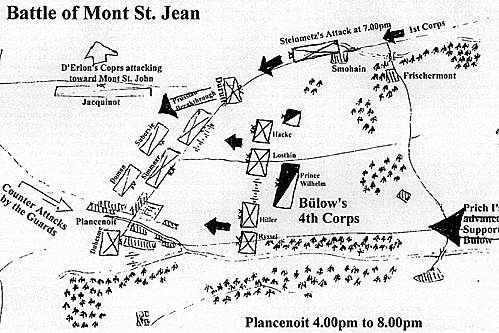"Vorwarts, Vorwarts, Kinder!"
The Prussian Campaign
in Belgium of 1815
Part II
18th June 1815
With 4 maps (slow)
by Patrick E. Wilson, UK
| |
18th June 1815: The March towards Plancenoit, the Battle of Mont St-Jean and the Battle of WavreTwo circumstances which could not have been foreseen on the 17th, were to produce delays in the advance of the Prussian Army toward Chappelle St.Lambert on the 18th. Firstly the extremely difficult conditions of the roads and ground following the heavy fall of rain the previous night and secondly, the massing of the entire Prussian Army in the nieghbourhood of Wavre. From midday on the 17th to the early morning of the 18th it had rained without ceasing, turning the countryside between Wavre and Mont St.Jean into a water logged landscape and putting all calculations of movement into doubt because of the mud the troopps would have to struggle through. That the Prussians arrived at Mont St.Jean at all, and with their artillery may be seen as little sort of a miracle. Difficulties however were somewhat further complicated by the concentration of the Prussian Army in such a small area, 90,000 men, all their equipment, horses and artillery were massed together around Wavre and the Dyle. Indeed, Bulow during his march had to pass through Pirch I's entire Corps, then navigate the narrow streets of Wavre before reaching open country. However, though Bulow's advance guard of General Losthin's 15th Brigade, with the 2nd Silesian Hussars and a 12Ib battery managed to reach their first objective of St.Lambert by 9.00am. The rest of Bulow's Corps found itself delayed at Wavre when a fire broke out at 8.00am and it took the 14th infantry regiment of Pirch I's Corps two hours to extinquish it. Therefore it would be noon before the main body of Bulow's Corps could join Losthin at St.Lambert and after 3.00pm before all the Corps was finally up. Luckily for Blucher, Marshal Grouchy because of his uncertainity about the direction of the Prussian retreat did not leave Gembloux until 9.00am with the main body of his troops, Vandamme's and Gerard's Corps. Though both Pajol and Exelmanns had started earlier. Exelmanns cavalry had made contact with the Prussian rearguard at the farm of L'Aucelle and Vieux Sart around 10.30am but like the 17th found himself only able to observe the larger formations of Prussians as they retreated into Wavre. However, both Bulow and Pirch I deployed troops to cover the movement of their troops in view of Exelmanns' presence. Bulow posted two Landwehr regiments at Vieux Sart and recalled Lieutenant Colonel Ledebur's detachment from Mont St.Giubert, this officer retreating via Pirch I's troops at L'Aucelle. Pirch I deployed the 7th and 8th Brigades under Brauze, together with von Sohr's hussar brigade at L'Aucelle. Whilst he took the remainder of his Corps, the 5th and 6th Brigades, Cavalry reserve and Artillery reserve in the wake of Bulow's Corps as their immediate support. General Brauze held L'Aucelle until 3.00pm when he withdrew through Wavre to rejoin Pirch I in the direction of St. Lambert and eventually reached Couture and Maransart by evening. After Brauze's departure only General Borcke's 9th Brigade remained on the south bank of the Dyle. Indeed, it had been Borcke's Brigade that had covered Brauze's retirement to and through Wavre, after which he too withdrew and followed Brauze's column as it marched on St. Lambert. However, Borcke also detached Colonel Zeplin to defend Wavre with two battalions of the 30th regiment (ex Russo-German Legion), a battalion of the 1st Kurmark Landwehr and Major Ditfurth with his rifle companies to hold the bridge at Bas-Wavre. 
Criticise It is of course easy to criticise Grouchy's performance in this period of the campaign, yet it ought to be remembered that his troops not only had to use roads already badly cut up by the passage of Prussian troops and rain of the 17th/18th June, but were also the very same troops that had borne the bulk of the fighting of the 16th and therefore needed time to recover. Nevertheless, these troops reached Exelmanns' Dragoos by 3.00pm and it would be their fire that would halt Thielemann as he was about to set off with his entire Corps in support of the rest of the Prussian Army as it attacked Napoleon's right flank. Thus, he was forced to deploy to defend Wavre and the rear of the Prussian Army. Zieten also found himself compelled to detach a force to defend the Dyle at Limale during his march from Bierges to Mont St.Jean, a march that only began at 2.00pm thanks to the delay caused by Bulow's and Pirch's Corps as they marched across his front. Colonel Stengel therefore occupied Limale with the 19th infantry regiment and 6th Uhlan regiment to project Zeiten's flank in that direction. Blucher arrived at Bulow's advance posts around midday, finding only half of Bulow's Corps there he was anxious to know what was before them. Had Napoleon occupied the Bois de Paris in order to defend his right flank ? Bulow's hussars soon reported it was free of the enemy though Blucher had this confirmed by two of his staff officers. Blucher there upon ordered Bulow's advanced forces, the 15th and 16th Brigades, the Artillery and Cavalry reserve immmediately forward to occupy the Bois de Paris. On reaching this forward position Blucher and his staff could clearly see the progress of Wellington's battle but what they saw also unnerved them. Welllington's centre seemed to be engulfed with French attacking forces, his artillery seemed silent, could it be that Wellington's front was breaking before they could effectively intervene. Courageously Blucher took the decision to attack with the troops he had at hand to relieve the pressure on Wellington, though Bulow pointed out that his 13th and 14th Brigades would soon be available and that it would be wise to wait but Blucher insisted. It was perhaps half past four as the 15th and 16th Brigades emerged from the Bois de Paris, Losthin's 15th on the right, Hiller's 16th on the left. To cover their flanks each officer had detached battalions, Losthin three in the direction of Frishermont and Smohain and Hiller two toward the Lasne stream. Napoleon, to cover his right flank had posted the cavalry of Generals Domon and Subervie, and somewhat later General Mouton's 6th Corps comprising of General Jeannin's and General Simmer's infantry divisions. It was against these troops that the Prussians now advanced. General Domon tried to take Losthin in the flank with his chasseurs a cheval but was repulsed by the 2nd Silesian hussars, 2nd Neumark and 3rd Silesian Landwehr cavalry regiments. The artillery of both sides soon opened up, Bulow's compelling Domon's defeated chasseurs a cheval to retire behind Mouton's Corps, who withstood Bulow's bombardment without flinching. Mouton's artillery even knocked out Bulow's 14th foot battery in reply. It was during this artillery exchange that Bulow's remaining Brigades arrived, the 14th moved to support Hiller's 16th and the 13th moved to support Losthin's 15th. Blucher then ordered Bulow to begin the attack. Meanwhile Mouton had fallen back to a position at right angles with General d'Erlon's 1st Corps facing Wellington's Army. His left flank rested on General Durutte's 4th division and his right on the village of Plancenoit. Mouton probably did this for two reasons, it secured his flanks and three battalions that Losthin had detached to the Prussian right had occupied Smohain and thus threatened his left flank. Shortly afterwards Bulow's attack got under way, the 15th and 13th Brigades pushing forward against Mouton's centre and the 16th and 14th Brigades pushing toward Plancenoit. The Reserve cavalry supported the 15th and 13th Brigades because of the presence of three French cavalry divisions in that area, the reserve artillery continued to bombard Mouton's centre. In addition, the commander of the 13th Brigade, General Hacke, detached another two battalions to support those Losthin had already sent to Smohain. Mouton's Corps though proved to be a tough nut to crack, the 15th and 13th Brigades making little impression. The 16th and 14th Brigades were just beaten to Plancenoit by General Bellair's brigade of the 5th and 11th ligne regiments but the sheer force of Colonel Hiller's attack with six battalions momentarily secured the village from Bellair's out numbered men. Hiller's triumph was to be brief, as Napoleon himself, realising the importance of Plancenoit, ordered General Duhesme's Young Guard division together with three horse batteries of the Guard to the rescue. These fine troops, just as they had done on the 16th at St.Amand, quickly ejected the victorious Prussians and secured the French rear from immediate danger. Duhesme then placed his artillery on the right of the village to enfilade Prussian attacks on the village, whilst his troops (16-18 year olds for the most part) barricaded, loop-holed and generally made each house within the village of Plancenoit a miniature citadel. 
Colonel Hiller, having now received explicit orders to capture Plancenoit, attacked again supported by two battalions of the 14th Brigade and despite the heavy fire of Duhesme's artillery penetrated to the centre of the village, gaining a foot hold in the church yard but the Young Guard's fire from the surrounding walls, gardens and houses proved too great, and despite the bravery and obstinary of his troops, Hiller found himself once more driven from Plancenoit. And yet, the brave Colonel reformed and attacked again with two of his battalions and four from the 14th Brigade and this time after severe fighting ejected the Young Guardsmen. Witnessing the scale of the Prussian assault on Plancenoit, Napoleon once more intervened, despatching two Old Guard battalions under General Morand to retake and hold Plancenoit. These troops, the elite of the entire French Army, retook Plancenoit from Hiller's exhausted troops at the point of the bayonet, so furious was their onslaught that it is believed they inflicted 3,000 casualties in this single charge and if it had not been for the fire of the Prussian artillery, which repulsed them beyond the village, they could have routed the 16th and 14th Brigades. As it was, these two Brigades were thoroughly shaken and it would need the interventin of Pirch I's Corps to renew the attack on Plancenoit, fortunately these were near at hand. Elsewhere Mouton had been joined by Durutte's energetic 4th division in defence of Smohain and Frischermont, which had successfully defeated an attempt by the Prussians at Smohain to advance on the hamlets of Papelotte and La Haye. Hamlets, Durutte himself had just taken from Wellington's Nassau troops. In the centre of the Prussian line, their Reserve cavalry acted as link between the infantry opposing Mouton and that opposing Duhesme and Morand but they suffered accordingly. Both Colonel Schwerin and Lieutenant Colonel Watzdorff being killed as well as nearly 400 of their men being rendered hors de combat. But here too, help was at hand, for Zieten's 1st Brigade under Steinmetz was approaching Papelotte and La Haye with orders to join Wellington's left.
The crisis of the battle had arrived for all concerned, for Blucher, Bulow's 32,000 men and eighty odd guns had been unable to break the resistance of French forces of half their number. Indeed, they had been badly beaten by them and therefore Blucher was anxious that his other Corps should appear soon and contribute immediately to the battle for Plancenoit. For Wellington, the situation was even more desperate though he had beaten off all Napoleon could throw at him. His centre was almost annihilated and therefore had to be filled up with troops from the flanks, he had already summoned a division from his right but for the left he needed Prussian help. Zieten had to replace the untouched brigades of Vivian and Vandeleur, which were urgently needed required in Wellington's centre. Napoleon himself was in somewhat of dilemma. True he had according to Marshal Ney smashed Wellington's centre but had ruined his heavy cavalry in the process and had held Bulow with minimal forces but now he had to take a gamble. Should he make a last ditch effort to win the battle with the Imperial Guard or use them to cover a withdrawal as it had become increasingly evident that Blucher's Prussian Army was beginning to appear in ever increasing numbers and Mouton could not be expected to hold them for very long.
Blucher in order to win at Plancenoit sent one of staff officers to Zieten with a direct order to come to the assistance of Bulow's Corps. Fortunately for Wellington, Blucher's liaison officer with the Anglo-Dutch Army, von Muffling, intervened successfully to prevent Zeiten marching off for Plancenoit just as Vivian and Vandeleur withdrew their brigades to Wellington's centre. It was not so fortunate for the Nassau troops under the Prince of Saxe-Wiemer, as these troops were wearing French uniforms dyed green and in the fading light of the day found themselves mistaken for the French by Steinmetz's troops and driven from their positions before Papelotte and La Haye with some loss. Eventually though, Steinmetz's troops joined up with those of Saxe-Wiemer and together they recaptured Papelotte and La Haye from Durutte's division. Then Steinmetz, pushing forward with four battalions, two rifle companies, four cavalry regiments and three batteries of artillery found himself between d'Erlon's right flank and Mouton's left at the very moment that Wellington had ordered a general advance following the repulse of the Imperial Guard. Steinmetz's appearance was decisive. Both d'Erlon's and Mouton's troops giving way to panic as they had taken him for Grouchy when he had mistakenly attacked the Nassau troops and they did not expect to see yet more Prussians.
Steinmetz's attack at Mont St.Jean has been seen as the most important allied attack of the entire battle because it broke the moral and cohension of the French Army. Indeed, if Durutte had held Steinmetz, Napoleon may have been able to retreat in a more orderly fashion and his remaining Imperial Guardsmen could, perhaps, have held the line Hougoument to La Haye until d'Erlon and then Mouton had retired to the high ground of La Belle Alliance behind Plancenoit. But this is only suppostion.
The climax of Blucher's battle was fought at Plancenoit. Tippelskirchen's 5th Brigade led the attack supported by five battalions of the 14th and 16th Brigades, all the valiant Hiller could rally. The 2nd Pommeranians and 5th Westphalian Landwehr regiment attacked the village frontly, whilst the 25th regiment attacked from the south. Plancenoit was by now held by ten battalions of the Imperial Guard, probably 4,000 men, and they had to be forced out house by house, farm by farm, wall by wall and hedge by hedge. Their resistance was ferocious. It took Tippelskircken's and Hiller's men one and half hours of the most appalling slaughter to clear Plancenoit of Morand's and Duhesme's men, who like true Guards fell where they stood, winning enough time for the remnants of the French Army to escape from Wellington and Zeiten's vengeful Prussians along the road to Genappe and Charleroi. The battle itself had cost the Prussians 7,000 casualties, though Wellington had twice the number and Napoleon four times the number.
Back in Wavre
Back at Wavre General Thielemann's 3rd Corps had been involved in a fight that had raged all day along the river Dyle. On preceiving the advance of Grouchy against Wavre Thielemann had positioned his available troops in the following positions. Colonel Stulpnagel's 12th Brigade on the heights in the rear of Bierges, barricading the bridge near that village and occupying a mill that spanned the Dyle. Colonel Kampfen's 10th Brigade on the heights in the rear of Wavre itself. Colonel Luck's 11th Brigade north of Wavre and on the heights above Basse-Wavre. General von Hobe's cavalry reserve was deployed at La Bavette and Thielemann's artillery was distributed along the front of his position. Three battalions of General Borcke's 9th Brigade still held Wavre itself, with rifle companies in Basse-Wavre and Aisemont. Away to Thielemann's right, Colonel Stengel held Limale with the 19th Regiment of infantry and 6th Uhlans. Unfortunately for Thielemann, Borcke had led the remainder of his Brigade for St.Lambert and Couture in accordance with 3rd Corps' original instructions.
At around 4.00pm Thielemann's outposts in the village of Aisemont came under attack, these fell back into Wavre as the French attack developed. Colonel Zeplin in Wavre then felt the whole weight of this attack, the French division of General Habert repeatedly assaulting his position. But despite the intensity of the attacks Zeplin's battalions, ably supported by artillery fire from the heights above Wavre, repulsed the French time after time. Habert himself fell wounded, as did over 600 of his men. The defensive nature of Wavre no doubt aided Zeplin's efforts but when we consider that for of his soldiers it was their first battle, it was a magnificant performance.
Eventually other parts of Thielemann's front came under attack, at least one assault was made at Basse-Wavre but Zeplin's riflemen held the French at bay. It was also at this time that the mill at Bierges came under heavy attack despite the sodden nature of the ground in that area. Elements of Colonel Stulpnagel's Brigade easily repulsed the first attack but more followed, the mill catching fire as fighting raged all around as Stulpnagel defeated his position against the increasingly furious attacks of General Hulot's 14th division of Gerard's Corps. One of the early casualities of the fighting being Gerard himself, who had to retire from the field. Indeed, it seemed that Thielemann was everywhere repulsing the French and that their forces most only be a weak detachment.
Unfortunately Colonel Stengel at Limale had been lax in his defensive measures, not even barricading the bridge and at 6.30pm he found himself taken by surprise. Suddenly French hussars were amongst his troops sabring left and right and Stengel had no choice but to retire to the heights above Limale, whilst the victorious French consolidated their gains with infantry and cavalry pouring across the bridge. Though help was at hand, for Thielemann had observed the movement on Limale as Grouchy sought to exploit his success by marching Gerard's Corps down from Bierges to support the breakthrough.
Thielemann ordered Stulpnagel forward to support Stengel with six battalions and supported him by bringing forward Kampfen's entire brigade from the Wavre area, in addition, General von Hobe's cavalry reserved moved forward to cover Stulpnagel's right. Stulpnagel launched five of his battalions in an effort to regain Limale but the fading light, confusing nature of the ground and the growing strength of the French ended in the Colonel calling the whole thing off as his second line collided with the first, and the French received his troops with a well directed volley. Luckily the French did not pursue as Stulpnagel fell back in confusion that evening. At Bierges and Wavre the fighting continued well into the night with the French still unable to dislodge the Prussian defenders.
Victory Heard
During the night Thielemann received news of Wellington's and Blucher's victory at Mont St.Jean, though interestingly enough, Grouchy did not. Consequently, Thielemann assumed the French would retire during the night and he would only have a rearguard to deal with as he went over to the offensive on the 19th. Colonel Stengel's detachment marched off to rejoin Zeiten during the night, forcing Thielemann to redeploy his Brigades again. Colonel Stulpnagel held a position between the Rixansart woods and Bierges, Colonel Kampfen held the left from Bierges to the river Dyle. Colonel Luck leaving two battalions of Kurmark Landwehr to support Wavre, positioned the remainder of his Brigade in the rear of Kampfen as support. General von Hobe's cavalry were formed in two lines on Stulpnagel's right in front of the Rixansart woods. Colonel von der Marwitz's first considered of the 8th Uhlans and 6th Kurmark Landwehr cavalry, Lieutenant-Colonel Lottum's second consisted of the 5th and 7th Uhlans.
Grouchy had also reorganised his frontline, with General Teste 21st division facing Bierges, General Vichery' 13th division opposite Colonel Kampfen and General Pajol's hussars supported by General Pecheux's 12th division facing Stulpnagel. General Hulot's battered 14th division was in reserve, whilst a Dragoon division under General Strolz watched the road to Chappelle St.Lambert. General Vandamme's 3rd Corps still faced Wavre with another Dragoon division in support.
Such were the positions of the Prussians and French as dawn broke on the 19th June, Thielemann aware that Grouchy must be in full retreat or just about to. Grouchy believing he had prevented a substantial portion of the Prussian Army from supporting Wellington on the 18th and that the 19th would bring victory, and ultimately a reunion with the Emperor's victorious forces in the direction of Brussels. The 19th June held surprises for both commanders.
Jumbo Battle of Mont St. Jean 18th June 4-8pm (very slow: 210K)
More Vorwarts Part II
Related
|

